
Are you a scuba diving enthusiast looking for the perfect dive knife to accompany you on your underwater adventures? Look no further! In this ultimate guide, we have compiled a list of the top 10 best dive knives available in the market.
It is a crucial piece of equipment that can come in handy during emergencies and can help you cut through fishing lines, kelp, or anything that comes your way. With so many different models available on the market, choosing the right one can be a daunting task.
We have thoroughly researched and tested each of these knives to provide you with a comprehensive review of their features, pros, and cons. In this article, we’ll explore the different types of dive knives, their features, and what to look for when selecting the best dive knife for your needs. So, let’s dive in!
Top 10 Best Dive Knives
We are excited to share our expertise on scuba diving knives with you. As seasoned divers ourselves, we understand the importance of having a reliable tool in hand, especially in emergency situations.
In this article, we will be discussing the key features of a quality scuba diving knife and the benefits of owning one. We aim to provide you with all the necessary information to help you make an informed decision when purchasing your own scuba diving knife.
We have compiled a list of the top 10 best dive knives that are sure to meet the needs of any scuba diving enthusiast.
1. SAALVI Dive Knife
The SAALVI dive knife is the first on our list because of its convenience and practicality. You can use this ergonomic and high-quality dive knife for a variety of tasks if you need one!
The SAALVI Dive Knife features a durable stainless steel blade that is resistant to rust and corrosion. The blade is serrated on one edge and straight on the other, making it versatile for a range of cutting tasks. The knife also has a sharp, pointed tip that is useful for piercing and prying. The handle of the SAALVI Dive Knife is made from a high-quality polymer material that provides a comfortable and secure grip, even when wet.
The knife also comes with a durable sheath that can be attached to a belt or diving harness for easy access. Therefore, you should make sure to bring the right tools with you, and a dive knife is among them. In this way, you will always be safe and able to overcome any obstacle.
Specifications
Brand: Saalvi
Weight: 6.4 ounces
Handle Material: Stainless Steel
Blade Material: Stainless Steel
Blade Shape: Straight Back
Color: Blue
Our Overall Review
4.2
Reasons to buy:
Reason to Avoid:
Where to Buy?
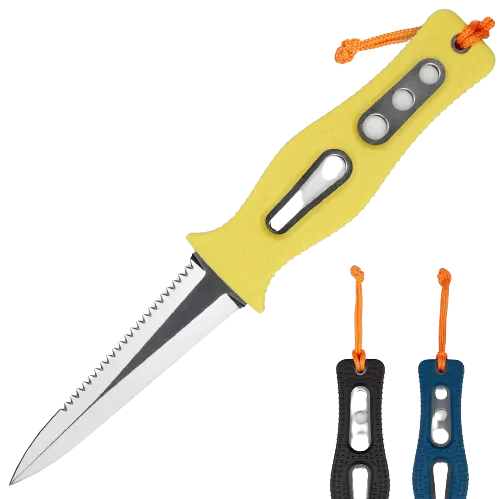
4.2 / 05
Saalvi Dive Knife
2. BOffer Scuba Diving Knife
The BOffer Scuba Diving Knife is a type of diving knife designed specifically for scuba diving activities. It is a sharp, pointed tool that is used for a variety of purposes while diving, such as cutting through fishing lines or kelp, prying open oysters, or as a safety tool in case a diver becomes entangled.
The BOffer Scuba Diving Knife typically features a stainless steel blade that is durable and resistant to rust and corrosion. The blade is typically between 4 to 5 inches in length and may have a serrated edge for added cutting power. The blade is often coated with a non-corrosive material to protect it from the harsh saltwater environment.
Specifications
Brand: BOffer
Weight: 5 ounces
Handle Material: Carbon Steel & Nylon Cord
Blade Material: Stainless Steel
Blade Shape: Straight Back
Color: Black
Our Overall Review
4.2
Reasons to buy:
Reason to Avoid:
Where to Buy?
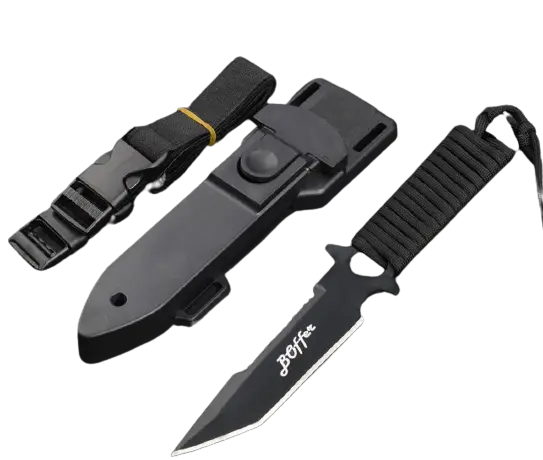
4.2 / 05
BOffer Scuba diving Knife
3. Cressi Short Blade Knife
The Cressi Short Blade Knife is a small but sturdy dive knife designed for underwater activities such as scuba diving, snorkeling, and spearfishing. The blade is made of high-quality stainless steel, with a serrated edge and a sharp point for cutting through ropes, lines, and other materials.
In our review of the Cressi Lima, the blade is just 2.44” long, making it the 1st shortest blade we have seen. Its slim handle makes it ideal for most people and great if you struggle with larger knives. In spite of this, if you have larger hands, you might find it challenging.
Specifications
Brand: Cressi
Weight: 1.7 oz
Blade Steel: Japanese 420-Stainless Steel
Sheath: Yes
Length: 4.33″ (110mm)
Color: Black
Our Overall Review
4.3
Reasons to buy:
Reason to Avoid:
Where to Buy?
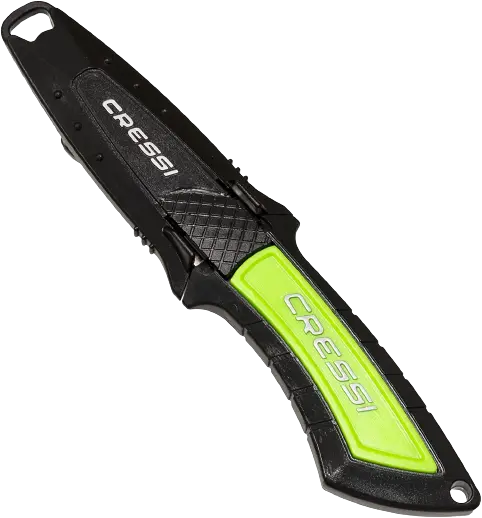
4.3 / 05
Cressi Short Blade Knife
4. Cressi Skorpion, Tempered Stainless Steel Blade Knife
The Cressi Skorpion is another popular diving knife from the Italian diving equipment manufacturer Cressi. It is a versatile and durable tool that is designed to be used by scuba divers and snorkelers, as well as other water sports enthusiasts.
The blade of the Cressi Skorpion measures just over 4 inches in length, which makes it longer than the blade of the Cressi Short Blade Knife. This longer blade can be useful for cutting through thicker materials or for tasks that require more reach.
The handle of the Cressi Skorpion is also designed with durability and grip in mind, with a non-slip rubber coating that provides a secure and comfortable grip even when your hands are wet. The knife also comes with a hard plastic sheath that can be easily attached to your diving gear for quick and convenient access.
Specifications
Brand: Cressi
Weight: 0.9 Pounds
Handle Material: Techno-Polymer
Blade Material: Stainless Steel
Blade Shape: Straight Back
Color: Blunt Tip Blue
Our Overall Review
4.6
Reasons to buy:
Reason to Avoid:
Where to Buy?
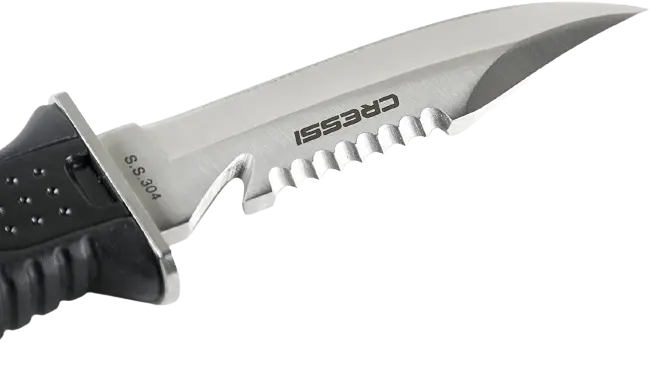
4.6 / 05
Cressi Skorpion
5. NRS Pilot Knife
The NRS Pilot Dive Knife is a versatile and reliable diving equipment that is ideal for both novices and experienced divers. It is designed to be highly durable, and it is packed with features that make it an excellent choice for any diving situation.
The NRS Pilot Dive Knife’s blade is made from 420 HC stainless steel, which is highly resistant to rust, corrosion, and staining. The blade is 3 inches long and has a straight edge, making it perfect for cutting through various materials. The blade also features a blunt tip, which can be used for prying open shellfish or other hard-to-open objects without damaging the contents.
Specifications
Brand: NRS
Weight: 5.5 oz
Handle Material: Glass-reinforced polypropylene
Blade Material: 420 HC Stainless Steel
Blade Length: 3″
Color: Black
Our Overall Review
4.7
Reasons to buy:
Reason to Avoid:
Where to Buy?
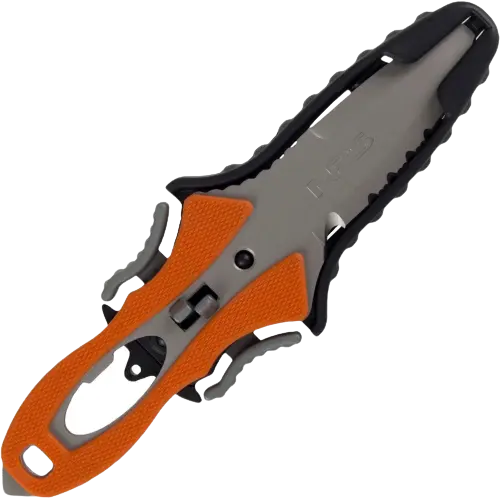
4.6 / 05
NRS pilot knife
6. Cressi Borg, Long Blade Knife for Diving
If you are looking for a knife that is specifically designed for diving, the Cressi Borg is an excellent choice. This long-blade knife is made from Japanese 420 stainless steel, which is a material known for its durability and resistance to corrosion.
It is made of high-quality materials and is designed to be highly durable, making it a reliable choice for any diving situation. The Cressi Borg features a sleek and modern design that is both attractive and functional.
The blade itself is 5.12 inches long, making it the perfect length for a diving knife. It is sharp enough to cut through ropes, fishing lines, and other materials that you may encounter while diving, yet not so long as to be unwieldy. The serrated edge of the blade makes it particularly useful for cutting through tough materials.
Specifications
Brand: Cressi
Weight: 0.25 Kilograms
Handle Material: Techno-Polymer
Blade Material: 304 Japanese stainless steel
Blade length: 145 mm
Color: Black
Our Overall Review
4.6
Reasons to buy:
Reason to Avoid:
Where to Buy?
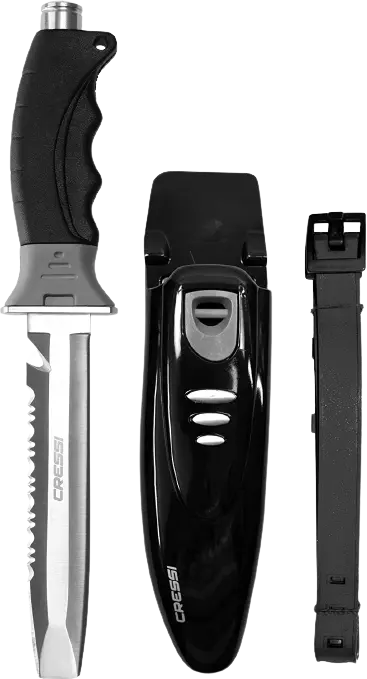
4.6 / 05
Cressi Borg
7. Audeamus Titanium Dive Knife
If you are looking for a dive knife that can withstand the toughest underwater challenges, look no further than the Audeamus Titanium Dive Knife. Made of high-grade titanium, this knife is incredibly strong, lightweight, and corrosion-resistant. The blade is sharp and serrated, which allows for a variety of cutting tasks.
The handle is ergonomically designed for a comfortable and secure grip, even with gloves on. The sheath is made of durable plastic and can be attached to your BCD, waistband, or leg for easy access. In short, the Audeamus Titanium Dive Knife is the ultimate diving tool that combines style, functionality, and safety.
Specifications
Brand: Audeamus
Weight: 0.31 Kilograms
Handle Material: Stainless Steel
Blade Material: Stainless Steel
Blade Shape: Straight Back
Color: Black
Our Overall Review
4.5
Reasons to buy:
Reason to Avoid:
Where to Buy?
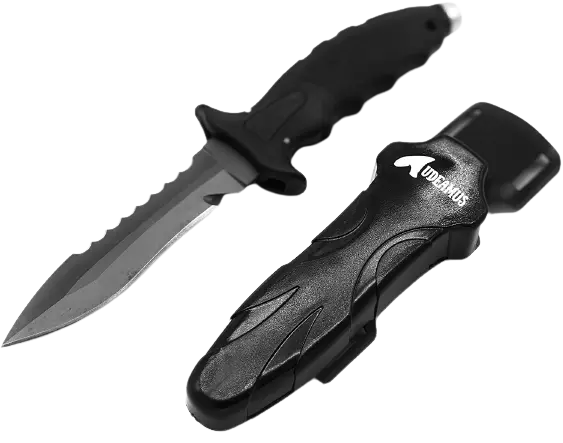
4.5 / 05
Audeamus Titanium Dive Knife
8. 5” Titanium Dive Knife
The 5” Titanium Dive Knife is a high-quality dive knife that’s made from premium-grade titanium. This knife is designed to be lightweight, durable, and easy to handle, making it the perfect tool for any diver. There is only one 5” diving knife on the list that comes with both sharp and blunt tips.
This makes them a low-maintenance option for divers who want a reliable and durable knife. The blade itself is 5 inches long, providing the perfect balance between size and maneuverability. It is sharp enough to cut through a variety of materials, including rope, fishing line, and kelp, while still being small enough to carry comfortably on your person.
Specifications
Weight: 7.1 ounces
Handle Material: Alpha (Hardened)
Blade Length: 4.7” (12.1cm)
Blade Material: 304 stainless steel
Color: Blue Blunt Tip
Our Overall Review
04
Reasons to buy:
Reason to Avoid:
Where to Buy?
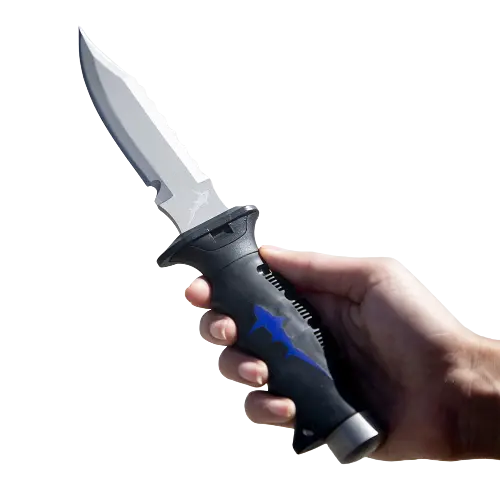
4.5 / 05
5” Titanium Dive Knife
9. Scuba Choice Scuba Diving Compact Black
Scuba Choice is a well-known brand in the scuba diving community, offering high-quality and reliable equipment for divers. The Scuba Choice Scuba Diving Knife is no exception and has been designed specifically for use in the water.
When compared to other dive knives on the market, the Scuba Choice Scuba Diving Knife stands out for its excellent combination of durability, performance, and affordability. It offers a sharp and durable blade, a comfortable grip, and a secure sheath at a price that is more budget-friendly than many other high-end dive knives.
Specifications
Brand: Scuba Choice
Weight: 0.31 Pounds
Handle Material: Stainless Steel
Blade Material: Nylon
Blade Shape: Straight Back
Color: Silver, Black
Our Overall Review
4.4
Reasons to buy:
Reason to Avoid:
Where to Buy?
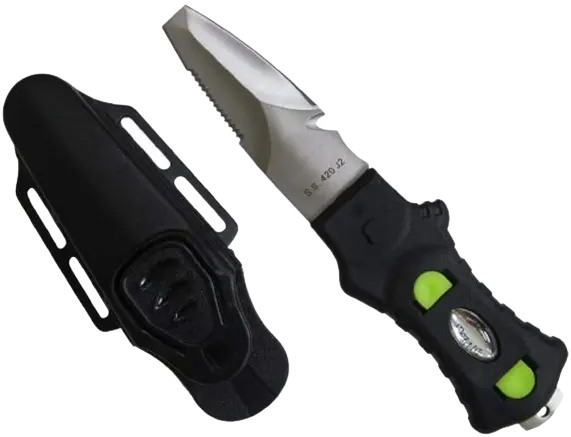
4.4 / 05
Scuba Choice Scuba Diving Compact Black
10. Promate Point Tip BC Dive Knife
The Promate Point Tip BC Dive Knife is a versatile and durable option for scuba divers in need of a reliable cutting tool. In addition to its functional use, the Promate Point Tip BC Dive Knife also has a sleek and stylish design.
There are lots of features to make this compact diving knife an excellent choice, including a line-cutting notch, a serrated edge, and a tank tapper. There is a notch on the blade’s main edge, which some find more natural. You can use the serrated spine to cut wood or cordage if you need to.
Specifications
Brand: Promate
Weight: 0.3 Pounds
Handle Material: Stainless Steel
Blade Material: Stainless Steel
Blade Shape: Spear Point
Color: Black
Our Overall Review
3.9
Reasons to buy:
Reason to Avoid:
Where to Buy?

3.9 / 05
Promate Point Tip BC Dive Knife
How to Choose the Best Dive Knife? Buying Guide
Choosing the best dive knife can be a crucial decision for any scuba diver. A dive knife is not just a tool for cutting through entanglements or fishing lines, it can also be a lifesaving device in emergency situations underwater.
When selecting a dive knife, there are several factors to consider, such as blade material, blade length, blade shape, handle material, sheath design, and overall weight and balance. The right dive knife for you will depend on your specific needs and preferences as a diver, as well as the type of diving you plan to do.
To help you get started on your search for the best dive knife, here are some key points to keep in mind:
- Quality
A dive knife’s quality and well-madness should be the first thing you consider. You should do this if you want your knife to provide you with the best possible performance, as well as last for a long time. Now that you know what kind of materials the product is made of, you can make sure it’s high quality.
You should look for stainless steel and titanium. The materials used in this knife will not only make it convenient and useful, but they will also make it long-lasting and durable. Before you buy a product, check the product description for this information so that you’ll know what to expect.
- Budget
The budget for a dive knife can vary depending on the brand, features, and quality of the knife. Generally, dive knives range from $20 to $200, with most mid-range knives falling in the $50 to $100 range.
When it comes to purchasing a dive knife, it is important to choose a knife that fits your budget and meets your needs. While a more expensive dive knife may have additional features or be made with higher-quality materials, a budget-friendly knife can still be reliable and effective if it is made with durable materials and designed for your specific diving needs. When setting a budget for a dive knife, it is also important to consider the potential cost savings of investing in a higher-quality knife.
Some budget-friendly dive knives are made with stainless steel blades, which can provide a durable and corrosion-resistant option at a lower cost. However, it is important to note that some lower-cost knives may have blades that are more prone to dulling or breaking over time, so it is important to choose a knife made with quality materials that can withstand the harsh underwater environment.
- Size
It’s probably a good idea to start by asking yourself where you intend to carry your scuba diver knife. Which dive knife size you choose depends on your answer. A dive knife can be as large as a full-sized knife attached to your lower leg or as small as a compact knife mounted on a belt loop or HP hose.
Among all-purpose knives, the K6 is an excellent example of a traditional-style full-sized knife. There are two quick-adjusting buckle straps that mount easily on the lower leg along with the big six-inch blade and ergonomic grip handle.
A diver knife, on the other hand, is like the White Tip. This type of dive knife is compact enough to attach to a hose or a BCD as a primary knife or to stow in an easy-to-reach pocket as a backup. The blade measures about 2.5 inches and the overall length is just under six inches.
- Length
Knives are measured by their handle and blade lengths. Your need for length will depend on what you will be wearing it. The length of your dive knife is an important factor to consider when choosing the right knife for your needs. The length of your dive knife will depend on your personal preference and the intended use of the knife.
Most dive knives range in size from 3 to 6 inches in blade length. A shorter blade length is ideal for divers who want a compact knife that is easy to carry and maneuver underwater. However, a shorter blade may not be as effective for cutting through tough materials.
- Design
The last thing you should consider when buying a dive knife is its design. You should make sure that the product is aesthetically pleasing to you, however, design is more than just how pretty it is.
Additionally, you should consider whether the knife features an ergonomic design that feels great in your hand and does not cause blisters.
As a result, you’ll be able to use it for an extended period of time without worrying about anything. To learn more about the design of the product you’re interested in, make sure to read both the product description and customer reviews.
Blade Material
When it comes to choosing the right blade material for your dive knife, there are a few factors to consider. Stainless steel is a popular choice as it is durable, rust-resistant, and easy to sharpen. However, titanium is also an excellent choice for divers who want a lightweight and corrosion-resistant option. Ceramic blades are also available, but they are not as durable as stainless steel or titanium.
The composition of your blade will determine how long it will last. It is common for dive knives to be made of steel, but titanium is also an option.
- Stainless Steel
The term “stainless steel” is misleading as they do rust, just more slowly than plain old steel, so maintenance will be required. Fresh water should be rinsed off your knife after every dive, and it should be left to dry unfolded or outside of its sheath.
Also, you can rub silicone on it or oil it. There is usually a series number on stainless steel knives, usually 300 or 400 series. Corrosive resistance is higher for blades with lower numbers.
Low-numbered blades, however, lose their edge more quickly. As a result, they each require their own special attention (more cleaning vs. more sharpening). While the 300-series knife won’t rust as quickly as the 400-series knife, the 400 will remain sharper; hence, they require their own special attention.
- Titanium
In addition to being nearly corrosion-resistant and rustproof, titanium dive knives do not contain any carbon to cause oxidation. With titanium dive knives, you can maintain an edge for a longer period of time and save money on maintenance.
In addition to being lighter and more flexible than steel, it is also more resistant to breaking. To maintain their quality, they must be maintained, even though they are much more expensive than their steel counterparts.
Edge and Tips
Style plays an important role in the functionality of your blade. The blade style you choose will depend on your personal preference and the intended use of your dive knife. Some of the most common blade styles include drop point, blunt tip, and serrated. A drop point blade is versatile and can be used for a wide range of tasks. A blunt tip blade is ideal for divers who want to avoid accidentally puncturing their diving gear or themselves. Serrated blades are excellent for cutting through tough materials such as ropes and fishing lines.
To ensure maximum safety and utility, consider the following styles:
- Consider a dive knife that has a dual straight and serrated edge for increased versatility. Plastics such as nylon rope and the line will cut easily with the straight edge; natural fibers such as rope and kelp will cut easily with the serrated edge. Make sure you have both types of blades available in case you need them.
- Prying, digging, hacking, and chiseling can all be accomplished with a blunt tip. It is less likely that you will puncture air hoses, your wetsuit, or another diver with a blunt tip. The blade is designed with safety in mind.
- Puncturing and cutting are made easier with a sharp tip. They’re popular with spearfishers and are great for cleaning catches. An edge that is sharp, however, is more dangerous, as it is more likely to cut or cause injury. Furthermore, the tip of the blade can break when you are digging or chiseling. It is generally less recommended for scuba divers to use sharp tips.
- Tanto tips combine bluntness and pointedness. Often with a spot of bluntness on the very tip, it has an angled tip that is sharpened for cutting. A gentle compromise has been reached.
Serrated vs Plain Edge
Since the invention of serrated knives, there has been a debate between straight and serrated edges. When purchasing a diving knife, it is important to consider the two types of blade edges because they serve different purposes.
If you are only given one option, you should choose a serrated blade since dive knives are meant to cut ropes and strong materials. It is best to use straight edges when cutting lines and finer objects.
The blade of many diving knives is serrated on one side and plain on the other. This would normally not be desirable on a knife, but dive knives are not used to puncture things, so having a cutting edge and a slicing-edge is beneficial.
Reliable Grip
A dive knife’s handle is another important aspect. There’s a tendency for things to slide around when you’re in or around water. When choosing a dive knife, you should consider the texture, shape, and material. Its textured handle keeps the knife firmly in your hand, while its shape makes it easier to grip.
Durable Sheath
Whenever you’re not using your knife-which is a vast majority of the time-the sheath prevents it from sinking into the abyss. It is important to know that the knife will be there when you need it.
A reliable sheath is one that fits properly on your body or equipment and has a sheath retainer, which is a device that prevents your knife from coming out unexpectedly. If you happen to be using a folding dive knife, many come equipped with clips instead.
Dive Knife Maintenance Tips
- Before the dive inspect the knife for corrosion. In case you discover that your dive knife has some rust spots, you can use a cleaning solution and wipe the blade with a clean cloth, a towel, or some soft steel wool.
- After that, you should check whether the locking mechanism on your knife and/or sheath works properly. If needed, lubricate it with silicone.
- If you can, disassemble your knife every once in a while. Remove a handle and give the tool a really thoroughly clean to make sure no salt or sand has found its way into the inner parts of the knife.
- Sharpen your dive knife if necessary. To sharpen a plain edge simply use a cross-hatched fine metal file. This way the edge will be sharp but rough. It will slice through the rope better than the stone-sharpened edge. If you need to sharpen a serrated blade, bear in mind, it is more difficult to restore without changing its shape. The process is also quite time-consuming, so it is best to sharpen your serrated knives only when you notice them becoming less effective. The most common way to sharpen serrated blade knives is with a sharpening rod. All you need to do is determine the side of your knife with a beveled edge and run the rod along each of the serrated scallops at an angle of the bevel (typically 13-17 degrees).
- After each dive rinse your knife with fresh water and scrub it to remove any leftover salt or debris. Dry the knife thoroughly.
- After you’re done diving for the day, you can coat the blade with silicone grease.
Finally remember, whichever knife you choose, you should never use it to harass marine life or destroy habitats. A dive knife is primarily a safety tool, not a weapon, so use it safely and responsibly.
Frequently Asked Questions (FAQs)
Conclusion
Choosing the best dive knife in 2023 can prove challenging, particularly if you’re doing it for the first time. However, you don’t have to struggle and do things the hard way.
By doing thorough research, comparing various options, and understanding the unique features and benefits of different dive knives, you can choose a knife that is both reliable and effective for your diving needs.
With our help, you can be done with your shopping journey in minutes and have your dive knife ready to go sooner rather than later. Whether you are a beginner or an experienced diver, investing in a high-quality dive knife can help provide added safety and convenience while diving. So don’t hesitate to choose the best dive knife for you and enjoy a safer and more enjoyable diving experience.

Waylen John
Editor, Co-Founder
at Letsdivehere.com
Waylen John grew up in New York and studied at the University of Columbia, He is an expert Scuba Reviews writer at letsdivehere.com
Waylen is a scuba diving enthusiast who has dedicated his life to exploring the underwater world. He is also the founder of Lets Dive Here, a website dedicated to promoting scuba diving and educating divers about the best scuba diving destinations around the world.
Waylen’s love for scuba diving began at a young age, when he discovered the beauty and mystery of the underwater world. He quickly became an experienced diver, and his passion for the sport led him to explore some of the most breathtaking scuba diving locations around the globe.
After years of scuba diving and traveling, John realized that there was a need for a centralized resource where scuba divers could learn about the best scuba diving destinations and connect with other divers. That’s when he founded Let’s Dive Here, a website that provides information on scuba diving locations, reviews of scuba diving gear, and tips for divers of all levels.
Lets Dive Here has become a go-to resource for scuba divers around the world. The website features detailed information on scuba diving locations in every corner of the globe, from the Great Barrier Reef to the Galapagos Islands. John’s passion for scuba diving is evident in every article, and his writing inspires readers to explore the underwater world.
Waylen is also an accomplished scuba diving instructor. He has trained countless divers over the years, and his experience and expertise make him a valuable resource for those looking to improve their scuba diving skills.
Waylen’s dedication to promoting scuba diving and educating others about the underwater world has made him a respected figure in the scuba diving community. He continues to explore new scuba diving locations and share his experiences with readers, inspiring others to take up the sport and discover the beauty of the underwater world for themselves.
